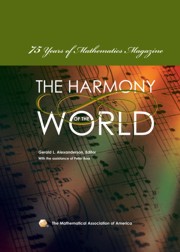Book contents
- Frontmatter
- Introduction
- Contents
- A Brief History of Mathematics Magazine
- Part I The First Fifteen Years
- Perfect Numbers
- Rejected Papers of Three Famous Mathematicians
- Review of Men of Mathematics
- Oslo under the Integral Sign
- Vigeland's Monument to Abel in Oslo
- The History of Mathematics
- Numerical Notations and Their Influence on Mathematics
- Part II The 1940s
- Part III The 1950s
- Part IV The 1960s
- Part V The 1970s
- Part VI The 1980s
- Briefly Noted
- The Problem Section
- Index
- About the Editors
Vigeland's Monument to Abel in Oslo
from Part I - The First Fifteen Years
- Frontmatter
- Introduction
- Contents
- A Brief History of Mathematics Magazine
- Part I The First Fifteen Years
- Perfect Numbers
- Rejected Papers of Three Famous Mathematicians
- Review of Men of Mathematics
- Oslo under the Integral Sign
- Vigeland's Monument to Abel in Oslo
- The History of Mathematics
- Numerical Notations and Their Influence on Mathematics
- Part II The 1940s
- Part III The 1950s
- Part IV The 1960s
- Part V The 1970s
- Part VI The 1980s
- Briefly Noted
- The Problem Section
- Index
- About the Editors
Summary
Editors' Note: Continuing his report of the Oslo Congress of 1936, Dunnington describes here the Abel monument in the Royal Park in Oslo, something that should be on any list of sights for mathematicians visiting the Norwegian capital. The sculptor, Gustav Vigeland, is best known for his many works in the gardens at Frogner Park in Oslo, but that collection contains no sculptures of mathematicians. For other versions of the statue of Abel and for maquettes produced in preparation for the piece in the Royal Park, one should visit Vigeland's house and studio, also in Oslo.
In 1908 Norway honored the memory of Niels Henrik Abel by erecting a monument of him in the park in front of the Royal Castle in Oslo. Gustav Vigeland, the leading modern Norwegian sculptor, created this monument. The late Felix Klein in his Vorlesungen über die Entwicklung der Mathematik im 19. Jahrhundert (vol. 1, p. 108) compares Abel and Mozart, speaking in this connection of the beautiful monument to Mozart in Vienna. But of the Abel monument he writes:
“I cannot avoid referring on this occasion to the entirely different sort of monument which has been erected to Abel in Oslo and which must severely disappoint everyone who knows his nature. On a lofty steep block of granite a youthful athlete of the Byronic type is striding upward, over two atrocious victims.
- Type
- Chapter
- Information
- Harmony of the World75 Years of Mathematics Magazine, pp. 19 - 22Publisher: Mathematical Association of AmericaPrint publication year: 2007

